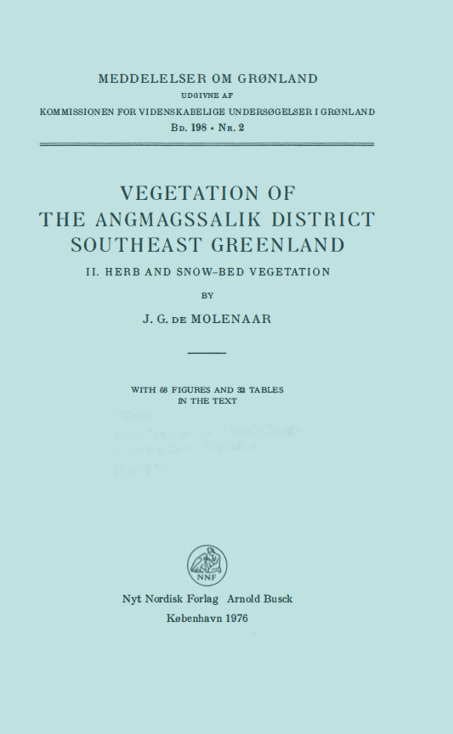Vegetation of the Angmagssalik District, Southeast Greenland. II. Herb and Snow-Bed Vegetation.
DOI:
https://doi.org/10.7146/mog.v198.147746Abstract
The present study deals with the major part of the results of observations made during expeditions in 1968 and 1969 to the central part of the Southeast coast of Greenland. The Angmagssalik District is a mountainous area deeply cut by fjords, and has a pronounced oceanic, low-arctic climate. The bedrock consists predominantly of Precambrian rocks. Soils are diverse and variable, shallow and of limited extent. Vegetation is of limited extent too and frequently acidophytic and more or less mesotrafent. The herb and snow-bed communities are distinguished and classified according to the principles of the Zilrich-Montpellier school of phytosociology as modified by Norwegian investigators. Altogether 15 sociations grouped in 5 complexes, 8 communities, and 38 associations (18 new ones), with 24 subassociations (all new) and a number of variants, classified in 16 alliances (2 new) with 3 suballiances (2 new), 13 orders (1 new) and 10 classes are recorded, described and discussed. The occurrence and composition of these communities appear to depend on a complex of interdependent conditions. Literature study shows that the majority have a wide, northern alpine to arctic, northern amphi-atlantic distribution. Aquatic and amphibious vegetation (Charetea, Potametae and Littorelletea) is scarce as suitable habitats are rare. Spring vegetation (Montio-Cardaminetea) is common, but of limited extent and dominated by bryophytes. Both acidophytic as well as basiphytic communities occur. Mires are varying in size, minerotrophic and found to represent the eutrafent to mesotrafent Parvocaricetea and a group of units intermediate between this syntaxon and the oligotrafent Scheuchzerietea. The more or Jess calciphytic Tofieldietalia is represented by communities grouped in the Caricion bicolori-atrofuscae and the Campylio-Tomenthypnion. Non-calciphytic, acidophytic to neutrophytic mire communities are represented by the Caricion curto-nigrae (Caricetalia nigrae). Three sociation complexes of Sphagnum-rich mire vegetation are considered to be intermediate. The extreme chionophytic units of the Salicetea herbaceae are found to occur in somewhat unstable soil. The oligotrafent ones and the mesotrafent to eutrafent, less extreme chionophytic vegetation are grouped in separate alliances. Related communities of highly unstable substrates are grouped in the Thlaspeetea rotundifolii. The chomophytic and chalicophytic communities are classified in the Androsacetalia alpinae. The tropohydrophytic communities of recent alluvia are classified in the Calamagrostion neglectae (Myricarietalia germanicae). Grass heaths are predominantly represented by non-calciphytic and nonbasiphytic types considered as belonging to the Nardo-Caricion bigelowii (Juncetea trifidi). Xerophytic talus-slide and rock vegetation is mainly represented by noncalciphytic chomophytic communities.

Downloads
Published
How to Cite
Issue
Section
License
Coypyright by the authors and the Commision for Scientific Research in Greenland. No parts of the publications may be reproduced in any form without the written permission by the copyright owners.

